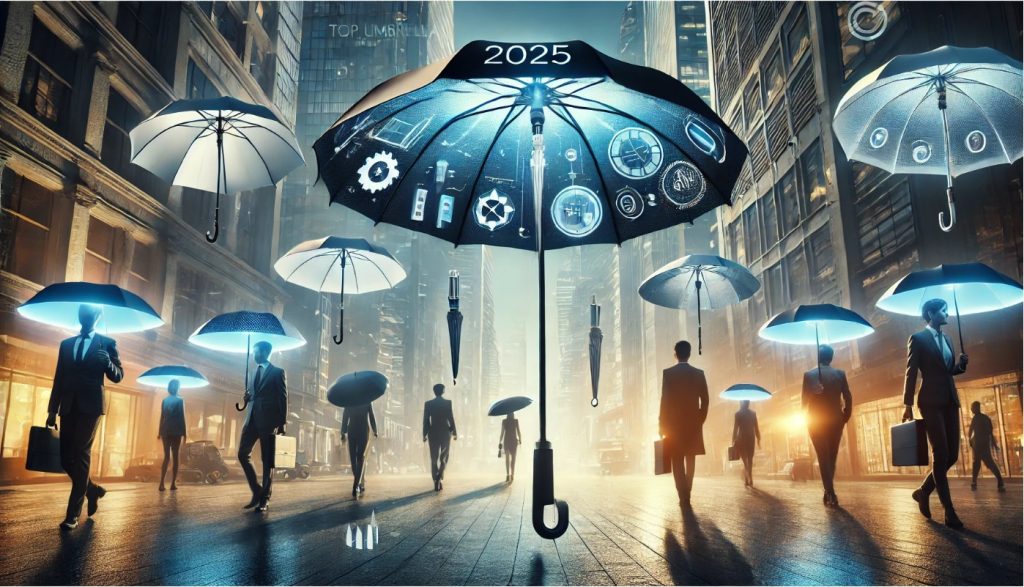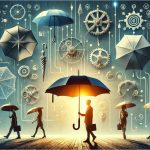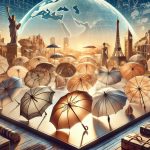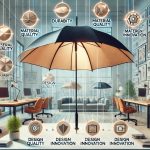The umbrella market has evolved significantly over the years, driven by technological advancements, changing consumer preferences, and an increasing focus on sustainability. By 2025, umbrella designs are poised to reflect even more cutting-edge innovations that go beyond traditional functionality. These innovations are not only making umbrellas more efficient at protecting users from the elements but also integrating new features that cater to consumers’ evolving needs, from style and convenience to sustainability and smart technology.
The Rise of Smart Umbrellas: Technology Meets Functionality
In recent years, smart technology has become an integral part of everyday life, and umbrellas are no exception. As we move into 2025, we can expect the umbrella industry to embrace even more advanced technological innovations, integrating smart features that enhance usability, convenience, and weather protection.
Umbrella Integration with Weather Forecasting
One of the most significant innovations in the umbrella market is the integration of real-time weather forecasting and weather prediction systems. Smart umbrellas are now able to sync with weather apps on a user’s phone, allowing the umbrella to automatically open or close based on weather conditions. These umbrellas can detect changes in temperature, humidity, or even barometric pressure, offering the ultimate convenience for consumers who no longer need to check the forecast before leaving the house.
- Automatic Opening and Closing: A key feature of smart umbrellas is their ability to open and close automatically. In 2025, we expect these features to become more refined and accessible, with umbrellas that can sense the need for protection against rain or sun, activating the opening mechanism without any manual intervention. This will especially appeal to busy consumers who are juggling multiple tasks and prefer hands-free convenience.
- Weather-Responsive Umbrella Systems: Umbrellas may also include features that predict when it will rain or stop raining and adjust accordingly. For example, a smart umbrella could notify the user via a mobile app when a sudden downpour is expected or when it’s safe to close the umbrella because the rain has stopped.
Bluetooth-Enabled Tracking Systems
One of the most common frustrations with umbrellas is losing them. Whether left on public transportation, in a café, or at a park, lost umbrellas are a frequent issue for consumers. In response, umbrella manufacturers are now embedding Bluetooth technology into their designs to help consumers track their umbrellas using smartphone apps.
- Umbrella Location Tracking: By connecting to a smartphone app, these Bluetooth-enabled umbrellas allow users to track the precise location of their umbrella, alerting them when they’ve left it behind or when it’s out of range. This technology minimizes the chances of losing an umbrella, ensuring that it’s always within reach.
- Lost Umbrella Alerts: Some models will feature built-in notifications that alert users when they are leaving their umbrella behind, sending a reminder through the app if they forget it in a public place.
Built-In Charging Capabilities
As we continue to rely more heavily on our smartphones and other portable devices, incorporating charging capabilities into everyday items is becoming increasingly popular. Smart umbrellas are now incorporating built-in solar panels or charging ports, allowing users to charge their phones while out and about, especially during rainy weather when people tend to have their phones out more frequently.
- Solar-Powered Umbrellas: These umbrellas feature solar panels integrated into the canopy, which can capture sunlight during the day and convert it into electrical energy. This energy can be used to charge small devices such as smartphones or portable power banks. Solar-powered umbrellas will be particularly popular in sunny climates, where they provide an additional practical function beyond just rain protection.
- USB Charging Ports: Some smart umbrellas are designed with a USB charging port, enabling users to charge their devices directly while sheltered from the rain. This innovation caters to tech-savvy consumers who want to ensure their devices stay powered, even when they’re on the go.
Enhanced Durability: Windproof and Waterproof Technologies
While smart umbrellas may take center stage in terms of technological innovation, durability remains a key focus in umbrella design. Consumers are looking for umbrellas that can withstand unpredictable weather, especially when facing strong winds or heavy rain. In 2025, expect to see even more resilient and durable umbrella designs that incorporate advanced materials and engineering.
Windproof Umbrellas with Reinforced Frames
One of the biggest challenges for traditional umbrellas is their tendency to collapse or flip inside out during strong winds. As windstorms and unpredictable weather patterns become more frequent due to climate change, consumers are increasingly demanding umbrellas that can withstand gusty conditions.
- Double-Canopy Designs: Wind-resistant umbrellas with double-canopy designs will continue to dominate the market in 2025. These umbrellas feature two layers of fabric that allow wind to pass through the top layer without flipping the umbrella inside out. This design reduces the risk of damage caused by strong gusts and ensures that the umbrella remains intact in stormy conditions.
- Reinforced Frames: Manufacturers will continue to use advanced materials like fiberglass and carbon fiber to create reinforced umbrella frames that can handle extreme conditions without breaking or bending. These materials are not only lightweight but also highly durable, ensuring long-lasting performance even during rough weather.
Waterproof Coatings and Materials
Waterproofing is another key consideration when designing umbrellas. As consumers demand high-quality rain protection, manufacturers are developing new materials that offer enhanced water resistance and faster drying times.
- Nano-Coated Fabrics: One major innovation in umbrella design is the use of nano-coating technology. These coatings are applied to the umbrella canopy, creating a water-repellent surface that ensures water beads off without soaking into the fabric. This feature enhances the performance of umbrellas in heavy rain, as the water is quickly diverted off the surface.
- Quick-Drying Materials: In addition to water resistance, quick-drying fabrics are becoming increasingly important. These materials allow umbrellas to dry faster after use, minimizing the risk of mildew or odor buildup. With the integration of these fast-drying fabrics, umbrellas will be more convenient and user-friendly, especially for consumers who need to pack them away quickly after use.
Sustainability in Umbrella Design: Eco-Friendly Materials and Practices
With growing awareness of environmental issues, consumers are increasingly looking for products that align with their values of sustainability and eco-consciousness. The umbrella industry is responding to this demand by incorporating more eco-friendly materials and sustainable practices into their designs. In 2025, sustainability will be a key driver of innovation in the umbrella market.
Recycled and Biodegradable Materials
One of the most significant shifts in umbrella design is the use of recycled and biodegradable materials. Manufacturers are beginning to embrace eco-friendly alternatives to the traditional plastic and metal components that make up most umbrellas.
- Recycled Fabrics: Many umbrella brands are using recycled polyester or nylon to create the canopy fabric. These fabrics are made from post-consumer waste, such as plastic bottles, reducing the need for virgin materials and helping to reduce plastic waste. These recycled fabrics not only offer the same level of durability and performance as traditional materials but also provide a more environmentally responsible option for consumers.
- Bamboo and Wooden Handles: The shift toward natural, biodegradable materials has also led to the rise of umbrellas with bamboo or wooden handles. These materials are renewable and biodegradable, making them a more sustainable choice compared to traditional plastic or metal handles. In 2025, expect to see more umbrella manufacturers using these eco-friendly materials in their designs.
- Biodegradable Umbrella Frames: Another exciting development is the creation of biodegradable umbrella frames made from sustainable materials such as bioplastics. These frames break down naturally after they have been discarded, reducing their impact on landfills and the environment.
Reduced Packaging Waste
The focus on sustainability extends beyond the products themselves to how they are packaged. Many umbrella manufacturers are adopting minimalist, recyclable, or reusable packaging options that reduce waste and lessen the environmental impact of their products.
- Recyclable Packaging: Umbrella packaging is moving away from excessive plastic and instead using recyclable materials such as cardboard, paper, or biodegradable options. Brands are also working to reduce the size of packaging, minimizing shipping costs and carbon emissions associated with transportation.
- Reusable Storage Bags: In an effort to reduce single-use plastic waste, some brands are offering reusable fabric storage bags for their umbrellas. These bags serve as both a protective carrying case and an eco-friendly alternative to disposable packaging.
Carbon Offset and Green Manufacturing Practices
Many umbrella manufacturers are also incorporating carbon offset programs and green manufacturing practices to reduce their environmental footprint. This can include using renewable energy sources in production facilities, reducing water usage, and ensuring that manufacturing processes are more energy-efficient.
- Carbon Neutral Brands: In 2025, we can expect to see more umbrella brands commit to becoming carbon neutral. By offsetting the carbon emissions generated during the production and distribution of umbrellas, these brands will appeal to consumers who want to make environmentally responsible purchasing decisions.
- Eco-Certifications and Transparency: To demonstrate their commitment to sustainability, many umbrella manufacturers are seeking eco-certifications or partnering with third-party sustainability organizations. These certifications help consumers make informed purchasing decisions and ensure that the brands they choose are genuinely committed to reducing their environmental impact.
Customization and Personalization: Tailored Umbrellas for Every Consumer
In 2025, the umbrella market is set to embrace more personalized designs, allowing consumers to create umbrellas that reflect their individual style and preferences. Whether through color, design, or function, customization is expected to play a significant role in future umbrella innovations.
Personalized Umbrella Designs
Consumers are increasingly looking for products that reflect their unique personality and lifestyle, and umbrellas are no exception. In response, manufacturers are offering customization options that allow customers to design their own umbrellas.
- Customizable Canopy Designs: Many brands are now offering tools that allow customers to select their preferred colors, patterns, or even upload their own artwork to create one-of-a-kind umbrella designs. This level of personalization is appealing to consumers who want a product that stands out and is unique to them.
- Monogramming and Branding: Personalized umbrellas with monogramming or logos have also gained popularity, especially in the luxury umbrella market. Whether as a fashion statement or for corporate gifting, personalized umbrellas add an extra layer of sophistication and exclusivity.
Interchangeable Umbrella Components
As consumers increasingly demand more versatile and functional products, umbrella brands are responding with interchangeable components that allow users to adapt their umbrellas based on their needs.
- Modular Umbrella Designs: Some brands are offering umbrellas with detachable canopies, allowing users to switch between different styles or materials depending on the weather. For example, a user could switch from a rain canopy to a UV-blocking canopy, making the umbrella suitable for both wet and sunny conditions.
- Adjustable Handles and Features: In addition to interchangeable canopies, umbrellas in 2025 may feature adjustable handles or detachable features, allowing users to tailor the umbrella to their preferences. Whether adjusting the length for more comfort or changing the handle for a better grip, these customizations will make umbrellas more user-friendly.
The umbrella industry in 2025 is set to witness significant advancements driven by the need for smarter, more sustainable, and highly customizable designs. With innovations like smart umbrellas, windproof technologies, eco-friendly materials, and personalized features, umbrellas will no longer just be functional items; they will be highly sophisticated tools designed to meet the needs and desires of modern consumers.







